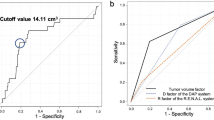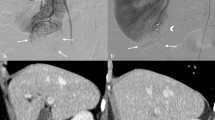Abstract
With the widespread use of abdominal imaging, there has been a substantial increase in the detection of incidental, small renal masses. This change has resulted in a downward trend in the size and stage of tumors being detected, and a corresponding increase in the number of renal cortical tumors amenable to partial nephrectomy. Based solely on a size criterion of 7 cm or less (pT1), nearly 70% of all patients with newly diagnosed kidney tumors are eligible for partial nephrectomy. Here, we briefly review the current rationale for partial nephrectomy and provide insight into advances in the technique of open partial nephrectomy. In addition to describing in detail the surgical techniques used at our institution, we also report the outcomes of our series of open partial nephrectomies performed via a mini-flank incision above the 11th rib. We believe that this approach offers a safe, practical and easily adoptable alternative to traditional open partial nephrectomy and laparoscopic partial nephrectomy.
Key Points
-
Despite equivalent oncologic results and renal functional advantages, partial nephrectomy continues to be underused for the treatment of small kidney tumors
-
Laparoscopic partial nephrectomy is an extremely challenging operation and associated with a greater risk of postoperative complications than open partial nephrectomy, even in expert hands
-
Open partial nephrectomy via a supra-11th rib mini-flank incision provides the safety and control of open surgery while reducing the morbidity associated with traditional open incisions
-
Open partial nephrectomy via a supra-11th rib mini-flank incision is a contemporary alternative to traditional open or laparoscopic partial nephrectomy and can easily be adopted by any surgeon comfortable with open renal surgery
This is a preview of subscription content, access via your institution
Access options
Subscribe to this journal
Receive 12 print issues and online access
$209.00 per year
only $17.42 per issue
Buy this article
- Purchase on Springer Link
- Instant access to full article PDF
Prices may be subject to local taxes which are calculated during checkout








Similar content being viewed by others
References
Jemal A et al. (2007) Cancer statistics, 2007. CA Cancer J Clin 57: 43–66
Chow WH et al. (1999) Rising incidence of renal cell cancer in the United States. JAMA 281: 1628–1631
Pantuck AJ et al. (2001) The changing natural history of renal cell carcinoma. J Urol 166: 1611–1623
Jayson M and Sanders H (1998) Increased incidence of serendipitously discovered renal cell carcinoma. Urology 51: 203–205
Russo P (2000) Renal cell carcinoma: presentation, staging, and surgical treatment. Semin Oncol 27: 160–176
Schlomer B et al. (2006) Pathological features of renal neoplasms classified by size and symptomatology. J Urol 176: 1317–1320
Nguyen MM et al. (2006) The evolving presentation of renal carcinoma in the United States: trends from the Surveillance, Epidemiology, and End Results program. J Urol 176: 2397–2400
Lee CT et al. (2000) Surgical management of renal tumors 4 cm or less in a contemporary cohort. J Urol 163: 730–736
Robson CJ et al. (1969) The results of radical nephrectomy for renal cell carcinoma. J Urol 101: 297–301
Fergany AF et al. (2000) Long-term results of nephron sparing surgery for localized renal cell carcinoma: 10-year followup. J Urol 163: 442–445
Dash A et al. (2006) Comparison of outcomes in elective partial vs radical nephrectomy for clear cell renal cell carcinoma 4–7 cm. BJU Int 97: 939–945
Leibovich BC et al. (2004) Nephron sparing surgery for appropriately selected renal cell carcinoma between 4 and 7 cm results in outcome similar to radical nephrectomy. J Urol 171: 1066–1070
Hollenbeck BK et al. (2006) National utilization trends of partial nephrectomy for renal cell carcinoma: a case of underutilization? Urology 67: 254–259
Huang WC et al. (2006) Chronic kidney disease after nephrectomy in patients with renal cortical tumours: a retrospective cohort study. Lancet Oncol 7: 735–740
Go AS et al. (2004) Chronic kidney disease and the risks of death, cardiovascular events, and hospitalization. N Engl J Med 351: 1296–1305
Russo P (2006) Open partial nephrectomy: an essential contemporary operation. Nat Clin Pract Urol 3: 2–3
Scherr DS et al. (2003) Practice patterns among urologic surgeons treating localized renal cell carcinoma in the laparoscopic age: technology versus oncology. Urology 62: 1007–1011
Stephenson AJ et al. (2004) Complications of radical and partial nephrectomy in a large contemporary cohort. J Urol 171: 130–134
Corman JM et al. (2000) Comparison of complications after radical and partial nephrectomy: results from the National Veterans Administration Surgical Quality Improvement Program. BJU Int 86: 782–789
Dunn MD et al. (2000) Laparoscopic versus open radical nephrectomy: a 9-year experience. J Urol 164: 1153–1159
Chatterjee S et al. (2004) Permanent flank bulge is a consequence of flank incision for radical nephrectomy in one half of patients. Urol Oncol 22: 36–39
Gill IS et al. (1995) Complications of laparoscopic nephrectomy in 185 patients: a multi-institutional review. J Urol 154: 479–483
Gill IS et al. (2003) Comparative analysis of laparoscopic versus open partial nephrectomy for renal tumors in 200 patients. J Urol 170: 64–68
Kava BR and Fair WR (1998) Partial nephrectomy. In Atlas of Surgical Techniques in Urology, 147–151 (Eds Whitehead ED et al.) vol 1. Philadelphia: Lippincott-Raven
Gilbert BR et al. (1988) Intraoperative sonography: application in renal cell carcinoma. J Urol 139: 582–584
Timsit MO et al. (2006) Prospective study of safety margins in partial nephrectomy: intraoperative assessment and contribution of frozen section analysis. Urology 67: 923–926
Diblasio CJ et al. (2006) Mini-flank supra-11th rib incision for open partial or radical nephrectomy. BJU Int 97: 149–156
Schiff JD et al. (2005) Laparoscopic vs open partial nephrectomy in consecutive patients: the Cornell experience. BJU Int 96: 811–814
Shekarriz B et al. (2002) Comparison of costs and complications of radical and partial nephrectomy for treatment of localized renal cell carcinoma. Urology 59: 211–215
Russo P (2005) Mini-flank supra-eleventh rib incision: effective approach to partial nephrectomy. Am J Urol Rev 3: 224–226
Author information
Authors and Affiliations
Corresponding author
Ethics declarations
Competing interests
The authors declare no competing financial interests.
Rights and permissions
About this article
Cite this article
Huang, W., Kagiwada, M. & Russo, P. Surgery Insight: advances in techniques for open partial nephrectomy. Nat Rev Urol 4, 444–450 (2007). https://doi.org/10.1038/ncpuro0855
Received:
Accepted:
Issue Date:
DOI: https://doi.org/10.1038/ncpuro0855
This article is cited by
-
Evaluation of nephron sparing surgery for renal tumors: a single institution experience
The Chinese-German Journal of Clinical Oncology (2011)
-
Retrospective study of the efficacy and complication of thoracoabdominal incision for nephrectomy: a comparison with flank approach
Frontiers of Medicine in China (2009)



